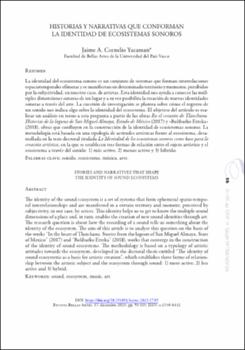Historias y narrativas que conforman la identidad de ecosistemas sonoros
Fecha
2023Resumen
La identidad del ecosistema sonoro es un conjunto de sistemas que forman interrelaciones
espaciotemporales efímeras y se manifiestan en determinado territorio y momento, percibidos
por la subjetividad, en nuestro caso, de artistas. Esta identidad nos ayuda a conocer las múl-
tiples dimensiones sonoras de un lugar y a su vez posibilita la creación de nuevas identidades
sonoras a través del arte. La cuestión de investigación se plantea sobre cómo el registro de
un sonido nos indica algo sobre la identidad del ecosistema. El objetivo del artículo es rea-
lizar un análisis en torno a esta pregunta a partir de las obras En el corazón de Tlanchana.
Historias de la laguna de San Miguel Almaya, Estado de México (2017) y «Bolibarko Erreka»
(2018), obras que confluyen en la construcción de la identidad de ecosistemas sonoros. La
metodología está basada en una tipología de actitudes artísticas frente al ecosistema, desa-
rrollada en la tesis doctoral titulada La Identidad de los ecosistemas sonoros como base para la
creación artística, en la que se establecen tres formas de relación entre el sujeto artístico y el
ecosistema a través del sonido: 1) más activo, 2) menos activo y 3) híbrido. The identity of the sound ecosystem is a set of systems that form ephemeral spatio-tempo-
ral interrelationships and are manifested in a certain territory and moment, perceived by
subjectivity, in our case, by artists. This identity helps us to get to know the multiple sound
dimensions of a place and, in turn, enables the creation of new sound identities through art.
The research question is about how the recording of a sound tells us something about the
identity of the ecosystem. The aim of this article is to analyse this question on the basis of
the works “In the heart of Tlanchana. Stories from the lagoon of San Miguel Almaya, State
of Mexico” (2017) and “Bolibarko Erreka” (2018), works that converge in the construction
of the identity of sound ecosystems. The methodology is based on a typology of artistic
attitudes towards the ecosystem, developed in the doctoral thesis entitled “The identity of
sound ecosystems as a basis for artistic creation”, which establishes three forms of relation-
ship between the artistic subject and the ecosystem through sound: 1) more active, 2) less active and 3) hybrid.





